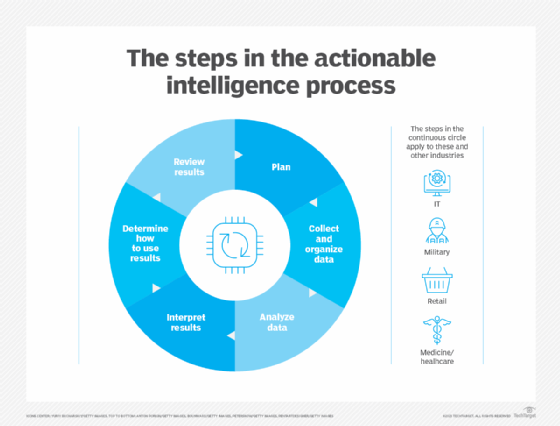What is actionable intelligence?
Actionable intelligence is information that can be immediately used or acted upon, either tactically in direct response to an evolving situation, or strategically as the result of data analytics or some other assessment.
It differs from intelligence, which provides details of a specific situation or circumstance, such as information that is good or useful to know, but not necessarily needed for immediate action. Regular intelligence isn't what a decision-maker, such as a corporate executive or military commander, needs to make decisions about a situation.
Both types of intelligence capture information from various data sources. They also both use mathematical algorithms, artificial intelligence (AI) and machine learning to generate insights.
Why is actionable intelligence important?
Actionable intelligence can lead to better decision-making regardless of the industry or situation. It lets systems and people make more accurate and timely decisions that improve performance and outcomes.
The intelligence platform being used determines the quality and usefulness of the information. The analytical process, if managed properly, can provide actionable insights on competitive intelligence, the impact of social media, product pricing, customer satisfaction and cybersecurity. Actionable intelligence makes determining the next step or action easier.
Who uses actionable intelligence?
The concept of actionable intelligence, or actionable information, applies to many different industries:
- IT. Actionable intelligence can be the result of data analytics, such as a log analysis. This sort of analysis can reveal systemic hardware or software issues that need to be addressed.
- Business. Actionable intelligence can be the result of big data analytics that provides insight into business operations and possible opportunities. For example, such analysis can provide new product or market opportunities. It can also identify business vulnerabilities such as a workflow bottleneck or inefficiency. In a business context, actionable intelligence is often referred to as business intelligence.
- Security. Actionable intelligence could reveal a tangible threat such as video surveillance or tripped alarms in a physical setting, or warnings from intrusion detection or antimalware software deployed within a data center infrastructure.
- Government. Actionable intelligence could result from a roadway or bridge inspection that indicates that repairs and upgrades to that physical infrastructure are required.
- Law. Actionable intelligence can mean that available information meets the legal requirements for a justifiable, or actionable, lawsuit.
- Military. Actionable intelligence from satellite and drone imagery can reveal troop and supply movements of enemy forces that need to be acted on.
- Medicine. Actionable intelligence can include data from medical devices. This could be test results or a big data analysis of medical images that helps doctors quickly diagnose issues and determine effective treatment.
How is actionable intelligence used in IT?
From a tactical perspective, actionable intelligence is an indication of an immediate threat or disruption, such as a system or application failure.
Tactical information is typically collected from software instrumentation, agents, logs, tools and platforms deployed within the IT environment. For example, agents might check on the heartbeat of key applications and services to ensure they're operational or use an intrusion prevention system to oversee the flow of network traffic and watch for anomalous activity.
Tactical information is usually delivered to IT administrators and other stakeholders in real time using dashboards and other messaging platforms such as texts and emails. A lost application or server heartbeat, or a potential network intrusion, produces an alarm to administrators.
Today, tactical information is coupled with automation to provide immediate, policy-driven responses to alerts and problems. For example, a lost heartbeat from a containerized application component could automatically respawn that container in an attempt to fix the problem without human intervention. Warnings and alerts sent to administrators are intended for follow-up and further investigation.
From a strategic perspective, actionable intelligence provides long-term assessments and analysis of IT infrastructure data over time and across the environment. Strategic information is collected from logs and analytical tools deployed and configured to track and report on key IT resources and assets.
For example, a system management tool or platform might watch the bandwidth use of major network segments, keep tabs on storage capacity and use, and correlate logs to look for potential system vulnerabilities and recurring errors that suggest an impending issue.
Strategic information is generally delivered to IT professionals and business managers in the form of periodic reports and visualizations, such as charts and graphs that illustrate trends. Reporting that shows increasing network or storage use might justify improvements or upgrades. Similarly, error or fault reports could call for preemptive system replacement or repair before an unexpected failure results in unplanned downtime.
Advantages and disadvantages of actionable intelligence
The adoption of actionable intelligence resources poses numerous benefits and challenges an organization must consider. Benefits of actionable intelligence in business and IT include the following:
- Opportunity. Combined with big data and AI analysis, actionable intelligence initiatives yield strategic insights, expose new business opportunities and reveal potential vulnerabilities, limitations and risks.
- Safety. Sensors and internet of things technologies deliver real-world data for real-time analysis. This data can be compared with known-good operational conditions to reveal possible sources of impending failures. For example, an air pressure sensor in a car tire can help drivers maintain optimum tire conditions for best mileage or alert a driver to a tire problem immediately.
- Availability. Knowing the operational condition of a device or system helps businesses take proactive steps to maintain equipment and systems to avoid unnecessary troubleshooting and extended downtime. For example, knowing that a server's power supply is delivering voltages outside of recommended ranges lets the operations staff or an automated orchestration tool move workloads to other servers and take the stricken server offline for repairs before its power supply fails.
- Revenue and cost-savings. Much of actionable intelligence in business and IT ultimately saves or helps make money. These outcomes include finding new opportunities to generate revenue, forestalling failures and extending system lifecycles to realize cost savings.
Despite the benefits, actionable intelligence does have disadvantages, such as the following:
- Cost. Actionable intelligence isn't free. An enterprise must invest considerable resources into building the computing infrastructure needed. This ranges from sensors to networks to computing and data sets, as well as the tools to process data and generate intelligence outputs. Additional staffing might also be needed to deploy, maintain and operate the intelligence infrastructure.
- Alignment. To get good, actionable information, a business must ask the right questions. This requires careful planning from inception and use case development, through design and deployment, to reporting and human follow-through. Actionable intelligence only has value when it has a purpose. Without business alignment, or purpose, insights can get missed, wasting the investment.
- Change. Actionable intelligence is an evolving effort as models change and new data becomes available. A business must regularly revisit its intelligence infrastructure and update those resources regularly to keep the effort relevant and useful. This requires ongoing investment.
- Reliability. These systems aren't perfect. A preemptive warning isn't a guarantee of impending failure, and a suggested business vulnerability isn't a foreshadowing of bankruptcy. Actionable intelligence can be wrong. Business and technology leaders must review output objectively and triage each warning or report based on business needs.
Intelligence vs. actionable intelligence
Intelligence is knowing what's going on. Actionable intelligence is knowing what to do about it. In practical terms, actionable intelligence is information that's coupled with intent or context.
Consider the example of a home thermostat that reports an uncomfortably warm indoor temperature of 82 degrees Fahrenheit. Simply knowing the indoor temperature represents intelligence; the current temperature measurement is little more than a data point.
The data becomes actionable when it's coupled with context such as the setpoint for a home heating and cooling system. When the homeowner sets the desired inside temperature to 74 degrees Fahrenheit, the thermostat's reading becomes actionable. It automatically engages the home's heating, ventilation and air conditioning system to cool the house to the desired temperature.
If the home's cooling system doesn't respond to the interior temperature or doesn't adequately drop over time, further action might be needed. This situation indicates a failure in the air conditioning system, which requires the direct intervention of the homeowner to schedule a repair.

How to use actionable intelligence
There are many types of actionable intelligence applied to industries from logistics to military to retail environments and beyond. Consequently, there's no single way to gather or use actionable intelligence.
Practitioners can often follow this six-step process:
- Plan. Any actionable intelligence project should start with the end goal in mind. Understand the purpose of the project, the project scope and how the organization will benefit from the results.
- Collect and organize data. With the goals in mind, consider the data that should be generated and collected to reach those goals. For business and IT-oriented projects, data collection typically involves deploying sensors and software instrumentation. The data can be entered into an intelligence platform or something as simple as an Excel spreadsheet for analysis.
- Analyze data. Consider how the collected data should be analyzed. Various types of data can require preprocessing such as data normalization and data cleaning. The business will rely on models and data analytics tools to ingest the data, perform correlation and processing, as well as yield outputs. The models and processing requirements vary, depending on the scope and goals of the project.
- Interpret results. Once outputs arrive, analysts can interpret the results, identify problems and formulate recommendations. Results might be general or detailed, depending on the complexity of the project and the data detail available.
- Determine how to use the results. With outputs in hand, business and technology leaders can make informed decisions about whether to take immediate action or plan long-term responses such as upgrades or other changes.
- Review results. The review is often the most difficult and overlooked part of the project. Practitioners must ask whether the actionable intelligence and the decisions arising from it had the intended impact on the business. If not, the project might need to be reevaluated. For example, if a logistics business fits sensors into its truck fleet to track locations to optimize routes, the business should objectively consider whether the optimizations improved delivery performance or saved fuel costs.
Business intelligence can give organizations an edge over their competitors. Learn about the role of augmented analytics and decision intelligence.







